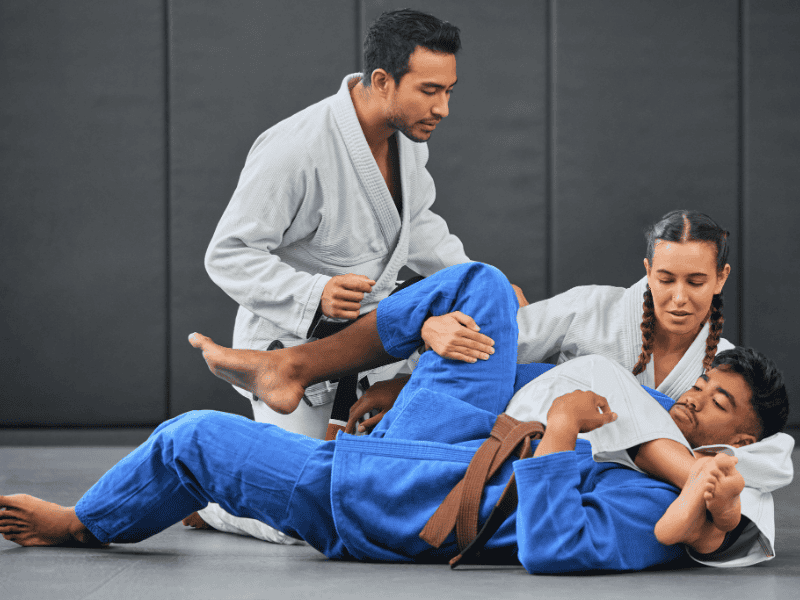Understanding the Stages of Learning in Martial Arts

How Newell’s Model of Motor Learning Can Help You Become an Extremely Effective Martial Arts Instructor
In a 1985 paper, groundbreaking motor control and learning researcher Karl Newell mapped out 3 stages of learning that have proved useful across occupational therapy, physical therapy, sports, and other motor activities. According to Newell, developing skill within a domain of motor activity follows 3 recognizable steps:
- Assembling a Coordination Pattern
- Gaining Control of the Coordinative Structure
- Skilled Optimization of Control
More recent research by scientists Keith Davids and Jia Yi Chow has built upon Newell’s model to make it more accurate for sports, like combat sports. In this article, we’ll explore Newell’s original model as well as the updated version so that you can understand what your students’ performances might look like at each of the martial arts stages.
Stage 1: Coordination
The first stage of Newell’s model is about finding suitable and functional (i.e., effective) movement solutions to the movement problems that present themselves to the learner in sparring. These initial solutions, most of which will be temporary, are known as coordinative structures.
More recently, Newell’s model has been modified to reflect new insights from current motor learning research. In this version, each stage of learning describes a perceptual (i.e., visual reading) and behavioral (i.e., tactical performance) level of skill. “Search and exploration” are those two levels of skill at this stage: search being the perceptual search for meaningful information from the opponent to regulate movement and exploration referring to the trying of several coordinative structures to see what works during sparring.
In the modified model, “education of intention” encapsulates the first stage of learning. Learners in this stage will show clunky, inefficient movements but will nevertheless find ways to accomplish their goals during sparring, albeit very inconsistently.

Stage 2: Control
The second stage of Newell’s model, the control stage, consists of exploring the coordinative structures in stage 1 to see if they can be flexible and scalable. Part of this process is synthesizing related coordinative structures found in stage 1 into fewer, more fluid, more widely applicable movement patterns.
Stage 2 is largely about taking disparate movement solutions and allowing all the solutions closest to each other to mesh into new, more flexible, more functional solutions. In the modified formulation of Newell’s model, “education of attention” dominates the second stage of learning, and is best described as a process of “discovery and stabilization.”
Discovery refers to a learner’s finding new cues from the way the opponent moves that can be paired with coordinative structures found during stage 1 and refined in stage 2 (for more information, read our article on motor control).
Stabilization refers to the process of finding which coordinative structures are the most useful across multiple situations in sparring. As some coordinative structures prove to have a wider range of utility, similar coordinative structures will be harmonized and consolidated into the more useful ones.
Stage 3: Optimization
Optimization characterizes Newell’s third stage of learning. At this stage, learners are able to scale their movements to opponent actions with apparent effortlessness. Learners here are continually looking for ways to do things more efficiently across the full range of sparring and competition.
In the modified model, stage three is characterized by “calibration,” also described as “exploitation.” In the context of kickboxing or taekwondo, this would look like skilled fighters scaling the power with which they throw their kicks, down or up, based on the forward momentum from their opponent or the lack of it, respectively.
In taekwondo specifically, athletes have to hit a power threshold on the electronic chest protector to register points. For maximum efficiency, a stage 3 fighter might calibrate the energy he expends, at any given scoring attempt, to approximate that pressure threshold and no more (e.g., capitalizing on opponent momentum or other physics-aided synergies to create maximum effect with minimal effort). This concept is well-known to martial artists as “economy of motion” -- but in a sparring context, economy of motion is always relative to the demands of the opponent, never isolated, and thus the quality of it is constantly in flux.
Caution: Performance & Learning are Nonlinear
If there’s one concept that all martial arts instructors of all styles need to understand today, it’s the “nonlinearity” of performance and learning. This means, essentially, that progression and improvement don’t always happen the way you expect them to happen after practice and instruction.
The so-called performance/learning paradox is the best and most important example of nonlinearity for martial arts instructors to understand. This is the phenomenon by which improvements in performance during practice do not necessarily represent motor learning, as measured by retention of said improvement in later practice sessions. The implications of this are massive to those of us who have become frustrated with students who seemingly “get” and then promptly “lose” technique improvements. I have a few observations here:
- Our frustration with students is unjustified when they’ve shown improvement during practice and then failed to perform to the same standard again in the next session or two.
- Intensive verbal feedback has been shown to produce transient and illusory performance improvements, and verbal feedback is very much overused in martial arts training vs other pedagogical methods.
- Given the performance/learning paradox, and we furthermore exacerbate that phenomenon with overreliance on verbal feedback, we must (a) allow students more time to exhibit stable learning and (b) find more productive means of teaching than just intensive instruction.
That said, progression through the stages can be nonlinear as well. For example, a learner whose skilled performance over time has placed him into stage 3 might see a sudden loss of the tactical flexibility that is indicative of stage 3 learning. This could represent a genuine loss of skill -- and thus a genuine regression of stage -- due to an injury or other condition.
But often this sudden, seeming regression in performance indicates a temporary performance decrement while movement patterns consolidate, which will jump back to stage 3 performance after a period of time. It could also represent an intentional “freezing” up, or making rigid, of a flexible movement pattern to make it more effective in specific situations.
In the latter two cases, the learner has not truly regressed from stage 3 but is either experiencing a gain in skill or intentionally changing performance, both of which only show temporary observable performance decrements. For this reason and many others, measurement of learning and classification of skill level should always take place over time and never immediately or in one session.
Conclusion
Karl Newell created a useful and insightful model of how learners progress through stages of development in a movement activity, and scientists have since come along and strengthened it to better represent sport. The modified and updated Newell model follows these stages, each representing a gain in both perceptual and performance skills:
- Search & Explore
- Discover & Stabilize
- Calibration & Exploitation
This learning model combined with insights into the nonlinearity of performance and learning can help us become more patient, accurate, and effective instructors of martial arts.
Here at Gymdesk, we have several features that can help you track the skill progression of your martial arts students. To find out more on how our software helps enhance martial arts schools, check out our Gymdesk martial arts page.
Resources
Button, C., Seifert, L., Chow, J. Y., Araújo, D., & Davids, K. (2021). 2nd Ed. Dynamics of skill acquisition: An ecological dynamics approach. Champaign: Human Kinetics.
Newell, Karl M. (1985). Coordination, control and skill. Vol. 27. London & New York: North-Holland. 306-311.
Renshaw, I., Davids, K., Newcombe, D., & Roberts, W. (2019). The constraints-led approach: Principles for sports coaching and practice design. New York: Routledge.
Gym management software that frees up your time and helps you grow.
Simplified billing, enrollment, student management, and marketing features that help you grow your gym or martial arts school.





